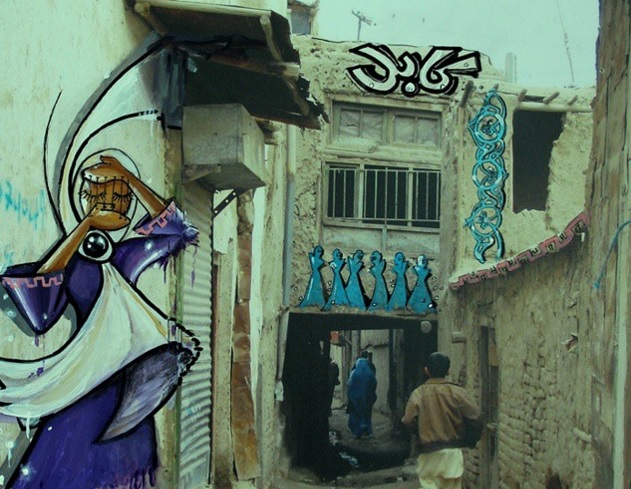By Frida Lundgren
In the midst of the hustling streets – crowded with shopping carts, watermelon stands, cars, motorcycles, bikes, donkeys, goats – is where you find them.
Walls decorated and beaming with colorful paintings – Blue, red, yellow, green, and purple. Portraits of street cleaners, women, cities, eyes and marks for peace – the street art of Kabul. Who would have known? Does a post-war city like Kabul really have time for street art? Is that secretly what the city is famous for?
Street art is far from the image that we normally associate with Kabul – that is, if we have an image at all.
Some of us are, perhaps, familiar the most famous historic and cultural sites of the city: Gardens of Babur, Kocha-e-Murgha (Chicken Street) or the Darulaman Palace.
But what about graffiti and street art?
The Afghan art scene is not often mentioned in the register of attractions, and Kabul is not usually listed as a destination for street art enthusiasts. But the truth is that the Afghan art scene, particularly the street art scene, has been flourishing over the past couple of years. Just take a look at the works by two of its contributors: Kabir Mokamel and Shamisa Hassani.
Let’s first take a look at Kabir Mokamel. Like many street artists, his paintings come with a message, and all have strategic locations. Mokamel wants to draw more attention to the Afghan graffiti scene, and hopes to put his country on the map for its creative street art. But more than that, he wants to work for a Kabul free from blast walls, free from battle scars, and free from political corruption.
#Afghan artist Kabir Mokamel is also using street art to send a political message @alibomaye http://t.co/C1hf8fVMEx pic.twitter.com/BCPlkbwzXB
— Frame By Frame (@FrameByFrameDoc) August 3, 2015
How can you move on from a negative past if you are constantly surrounded by physical reminders of it?
Mokamel’s simple solution: to paint and decorate the reminders. With the help of volunteer artists, Kabir Mokamel brings back color to the formerly green and blooming city of Kabul, and turns blast walls into glowing canvases.
His art works are filled with symbolisms and include several hot topics: women’s rights, ethnic differences, skewed heroism and corruption. This example shows the accusing eyes of a Sikh Afghan woman, and reminds its audience of racial inclusiveness and to watch out for corruption.
Mokamel’s works are sponsored only by Afghan donations and are put together by volunteers, passers-by, and any ordinary Afghan who wants to join his project.
And then there is the street artist and women’s rights activist Shamsia Hassani.
Much like Mokamel, Hassani wants to work for a colorful Kabul, free from war memories and protective walls. With her portraits of women and cities, she spreads positive sentiments and shows the capability of Afghan women. Her works decorate walls, houses, abandoned buildings and streets all across Kabul. Through the imaginative work of her spray-cans, Hassani wants to push Afghans to rediscover the beauty in their capital city.
She wants to work for an Afghanistan that is famous for colors and art – not war.
Hassani is often celebrated as the number one street artist in Afghanistan, and has been nominated for numerous awards. She works with her paintbrushes and spray-cans directly on the streets, and also pastes finished works from her studio in the streets.
With several up-and-coming street artists working in Kabul, it may not be long before it is added next to Berlin, Buenos Aires and Los Angeles in the list of street art destinations.
Could this be Kabul’s new identity – next to the hustling and bustling image of a busy city – the home of some of the world’s most famous street artists?
This piece was originally published on A Teaspoon of (لیمون) Zest.




















[…] Click here to view original web page at Kabul – the home of street and graffiti artists […]
I would have never imagined Kabul to be a city for street art! It’s great to know about the cultural things happening there!